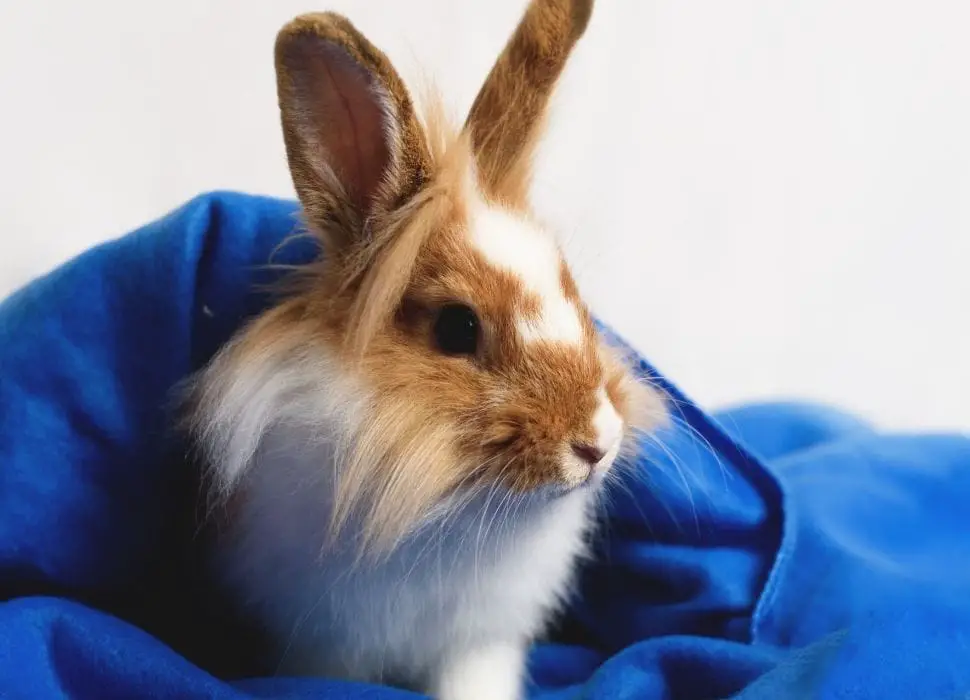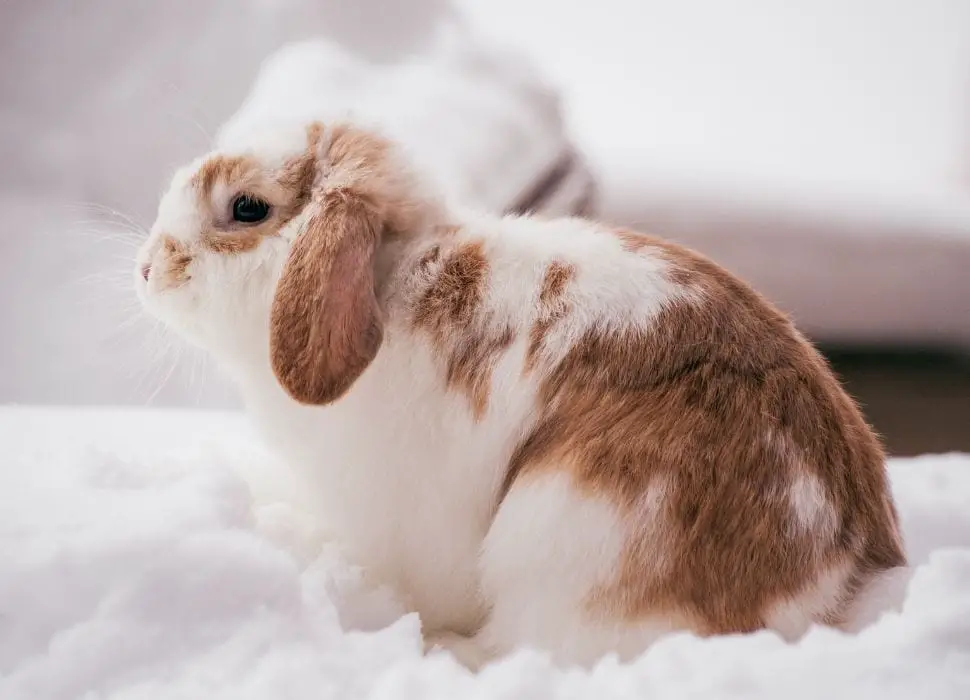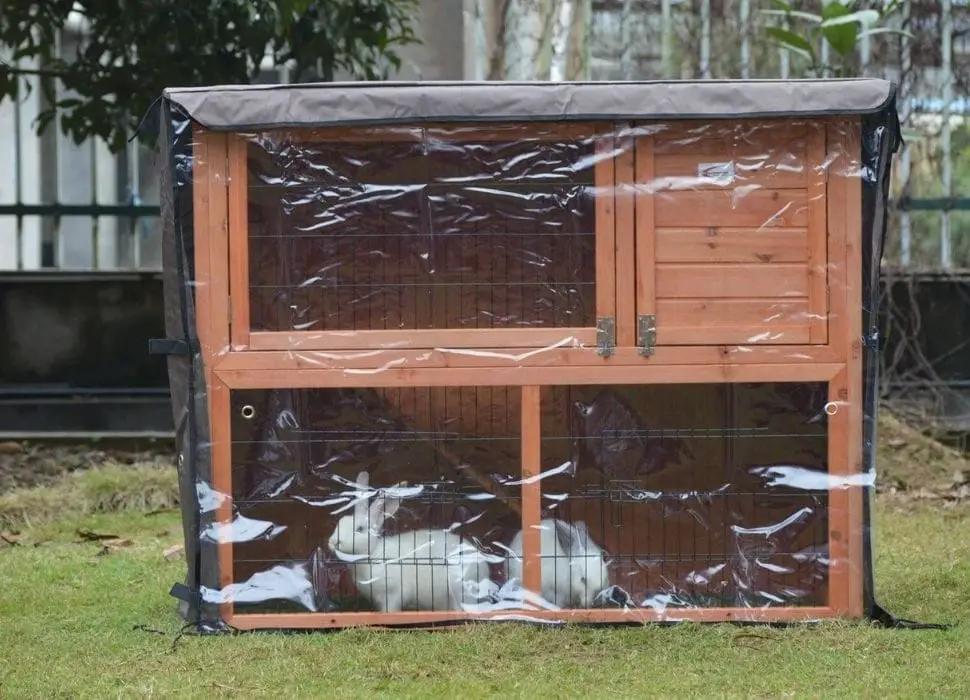Although domesticated rabbits share similarities with their wild relatives they are not quite as well equipped to deal with the cold. Wild rabbits live in perfectly designed underground burrows that retain the body of all its bunny occupants, keeping them all warm and cozy during the winter. Wild rabbits are even born with fur which helps them to survive in cooler temperatures.
Acclimatized rabbits are tolerant of cold temperatures (even those just below freezing), however, here are some quick steps you can take to ensure your rabbit stays warm outside even in winter.
- Ensure the hutch is in a sheltered location and out of direct wind and rain
- Insulate the hutch or cage with newspaper and cardboard
- Use a hutch cover overnight and during periods of inclement weather
- Ensure hutches are cleaned daily and any soiled substrate is replaced
- Provide an unlimited amount of hay and replace daily
- Consider a companion or use a microwaveable heat pad to provide extra warmth
- Ensure the rabbit always has fresh water
Domesticated pet rabbits generally live inside the home (free roam house bunnies) or outdoors in a hutch. If kept inside the house bunnies are usually very comfortable as they enjoy sharing our cozy temperatures and home comforts, however, if rabbits are kept outside in hutches owners should take extra care and to make sure their health is not at risk from extreme cold weather.

Do Rabbits Hibernate?
Rabbits do not hibernate like other animals and survive by foraging for food. In winter months when vegetation is more scarce or hidden under snow, wild rabbits increase their intake of alternative food sources such as tree bark and leaves. Domesticated rabbits kept outside also use food as a way to regulate their temperature.[spacer height=”20px”]
What Temperature is Too Cold for Rabbits?
Although rabbits are naturally cold-weather animals with a normal body temperature of between 100.5 and 103.5 degrees Fahrenheit (or 38.5 – 40° celsius), any temperature below freezing will be uncomfortable unless they are adequately protected from the elements like wind and the damp. If the temperature gets colder and falls to – 7 degrees centigrade or below a rabbit is at risk of developing hypothermia.
How Do You Take Care of Rabbits in the Winter?
Bunnies seem to be happiest inside the home but even if you have to keep them outside there’s plenty of ways to make sure they have a happy and healthy life.
Rabbits are susceptible to temperature extremes of both heat and cold so it’s important you make sure they are neither too hot in summer or too cold in winter. It’s the latter we’ll be discussing here but we’ll cover heat extremes in a future post.
The main things that you should pay attention to in order to keep your rabbit is comfortable during winter are covered here.

The Rabbit Hutch
Hutches are a bunny’s main source of protection and it’s important to make sure they are safe and fit for purpose before winter comes around. Hutches are generally constructed from wood which is susceptible to damp rot and mold spores from these conditions can be particularly bad for a bunny’s respiratory system.
Inspect the hutch thoroughly, replacing any rotten wood panels. If your hutch was unstained when you purchased it now is a good time to paint or varnish it with a preservant. Use a non-toxic substance such as a fence or shed paint that won’t harm your bunny if (when) it decides to chew it. Paint should be reapplied every year.
Check the waterproof roof felt on top of the rabbit hutch for any rips or tears which might allow in water and patch or replace with new felt if necessary.
If your hutch doesn’t already have legs you can either add some or simply use bricks to lift it off the floor. This will stop frost and water damage to the bottom and make it more difficult for any predators to peer in.
If possible place the hutch in a sheltered area out of direct wind. A Garage is also OK provided it’s not used for cars as dangerous exhaust fumes can be fatal.
Alternatively, a fitted hutch cover such as this one linked here on Amazon will protect your rabbit from the wind and the rain while still allowing sufficient ventilation and airflow, therefore, preventing the environment from becoming too hot.

A warm bed
Rabbits enjoy comfort just as much as we do so providing them with a nice warm bed is very important. Inside the hutch place a layer of newspaper as insulation and cover it with a thick pile of Timothy hay. Your rabbit will, of course, chomp its way through the tasty hay and will poop and pee in it so this needs to be changed daily to ensure it doesn’t become uncomfortable.
Fleece blankets also make great warm bedding for rabbits however should be given in addition to hay and not instead of hay. Fleece blankets can be folded into quarters and a microwaveable heat pad such as the snugglesafe pet pad pictured below (and linked here on Amazon) can be added in between one of the layers to create a cozy bedding that will keep a rabbit warm for several hours.
Food and Water
Rabbits generally eat more during winter as extra calories are needed to regulate the body temperature in the cold weather, however, regardless of the season an unlimited amount of timothy hay should be provided, and providing this is available, your pet will feed itself the amount it needs. Provided your rabbit’s weight stays consistent and you have taken steps to ensure warmth in the hutch through the actions described above.
Rabbits should go no longer than about 8 hours without water so it needs to be available at all times. You will need to take steps to prevent your rabbit’s water source from freezing and there’s a couple of ways to do this depending on whether you use bottles or bowls.
Insulated water bottle covers such as the one pictured below will protect water bottles from frost, alternatively, if you are on a budget you can cut a hole in a large sock. An elastic band can be used to keep the makeshift bottle cover in place.
For water bowls, a Snugglesafe Microwaveable Pad can also be used as a heated base for a water bowl. These are great as they stay warm for approximately 8 hours and can be used overnight. These are great as they will keep the water from freezing but won’t warm the water to a temperature that will do any will harm to your pet.

Check the water several times a day to ensure your pet has uninhibited access. Pay particular attention to bottle spouts with a ball bearing as these can freeze up completely.
Exercise
Bunnies love to play and seem to love the winter just as much as they enjoy the warmth of a summer evening. Even weather conditions such as snow cannot dampen a bunny’s enjoyment of playing so contrary to keeping them in over the winter, they need just as much exercise outside the hutch during these months as they do any other time of the year.
Ideally, your rabbit needs access to a secure run 24/7. At the very least, a couple of hours of exercise either in a secure space or garden or perhaps inside the house will do.
If your rabbit does enjoy the snow, ensure he is given time to dry off after his playtime, never put back in his hutch with a wet coat when the temperature drops overnight.
Companionship
Wild bunnies rely on the body heat of other colony members to keep warm inside the burrow so not surprisingly the number one thing you can do to keep your pet rabbit warm in the colder seasons is to ensure it is has a friend.
Rabbits that live outdoors in hutches should under no circumstances live on their own and should be bonded as soon as possible (and well before winter comes around) to a neutered or spayed companion.
Health Issues
Despite all of the things you can do to keep your bunnies warm remember they are fragile animals so paying close attention to them over the winter to ensure that they are in good health is vital.
As rabbits deteriorate quickly we recommend that if you spot any of the following tell tale signs of hypothermia or are at all worried about the effect of the cold on your rabbit during the winter you should bring them indoors and wrap them immediately in a dry towel or fleece blanket to warm up. If symptom persist take them immediately to a vet.
These symptoms can include:
- Runny nose
- Eye discharge
- Distress
- Shallow breathing
- Lethargy
- Cold/pale limbs and ears
- Weak heartbeat
Other Things to Remember
- NO Electric Blankets or Hot Water Bottles! rabbits will pee and poop on fabrics not to mention chewing on wires. Electric blankets will put your pet at a high risk of electrocution while hot water bottles may result in scalding.
- Plastic bottles may crack if allowed to freeze so always have a spare available. Glass bottles are highly recommended for outside use as they will freeze slower.
- Always keep baby bunnies indoors, domestic babies are not equipped for cold weather.
- Adult rabbits will take time to get used to a cold climate also so if you intend to keep a rabbit out for the winter make sure it is there for at least a few months prior. This will allow the pet sufficient time to grow its winter coat.
Further Reading
How to keep your rabbit warm & healthy in winter best4bunny.com
How to keep your rabbit warm in winter vets-now.com
3 ways to keep rabbits warm in winter petplan.co.uk


